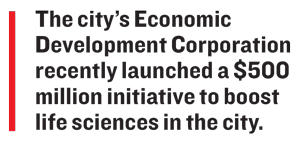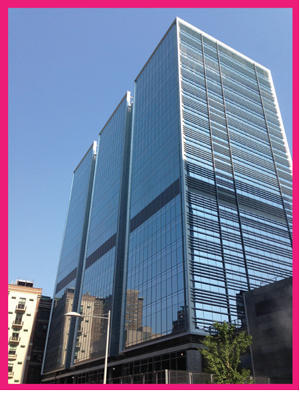Taconic Investment Partners and Silverstein Properties are betting big on a 10-story office building they co-own on Manhattan’s Far West Side as a hub for life science tenants.
The duo, which bought a majority stake in the former industrial building at 619 West 54th Street last year, is pumping $20 million into the site to turn it into a life science center. Rather than holding meetings in boardrooms, tenants will huddle around petri dishes and microscopes, discussing everything from DNA to stem cells.
Features in the building include a generator with 1 megawatt of emergency power, electrical capacity of up to 25 watts per square foot and a pH neutralization system — all necessary to ensure that the sensitive materials tenants are working with are not compromised.
The L-shaped property, which is valued at more than $180 million and sits between Eleventh Avenue and the West Side Highway, was used by Warner Brothers in the 1930s as a film production studio. But Silverstein and Taconic are now eyeing research and pharmaceutical tenants for the space.
That, however, wasn’t the original plan. When Taconic bought the roughly 327,000-square-foot building for $112 million six years ago, the firm was not thinking about the life science sector. It viewed the purchase as a good opportunity to invest in an emerging neighborhood.
“We like the area, we see it’s getting better and better, and we thought that this building was really high quality,” said Taconic’s senior vice president, Matthew Weir, who noted that the firm also like the block’s liberal zoning.

But then the New York Stem Cell Foundation came knocking. The nonprofit, which focuses on stem cell research, now occupies 42,100 square feet in the building. Other tenants include the Manhattan Surgery Center and the Rogosin Institute, which treats kidney disease.
Silverstein’s CEO, Marty Burger, said the goal is to have more than half the building leased to tenants in the fast-growing field by next year.
“We actually renamed it the Hudson Research Center and are prebuilding a lot of spaces in the building for life science tenants to be able to come in and just set up shop,” he said.
But despite the increased interest in life science and biotech in New York, the city is still playing catch-up to such rival cities as Boston, San Francisco and San Diego. Multiple sources pointed to real estate as one of the main reasons for the lag, citing zoning issues and the high cost of building lab space in Manhattan and the outer boroughs. As of July, the city had just 2.6 million square feet of space available for life science organizations. That’s compared to a massive 26.8 million square feet in the Greater Boston area and 16.1 million square feet in New Jersey, according to JLL.
In May 2017, the U.S. Department of Labor put the New York metro area in sixth place for number of jobs in the life science industry with about 190,000 — far behind the Boston area, which ranked No. 1 with 650,000 jobs. (Minneapolis ranked second with 380,000, followed by Washington, D.C., with 240,000.)
Altogether, the sector employed about 7.1 million people nationwide at that time, and it was expected to grow 10 percent between 2016 and 2026, according to the agency.
While New York is attempting to capture a larger piece of this growing field, Burger stressed that it will ultimately require developers to take some chances with their money.
“It’s very hard to lease office space to a life science tenant unless you’ve already built out the space to be a wet lab space, and so that’s incumbent upon a landlord to make that investment and then take the risk,” he said.
Lab limitations
Some of the bigger life science backers in New York are national real estate investment trusts. The urban office REIT Alexandria Real Estate Equities, for example, is behind the Alexandria Center for Life Sciences complex at 430 East 29th Street. Tenants include such large global firms as Bristol-Myers Squibb and Pfizer and newer companies, including Intra-Cellular Therapies and Petra Pharma Corporation.
Joel Marcus, founder of Alexandria Real Estate Equities, said it takes four things to create a vibrant cluster of tenants in the field: world class science, world class locations, venture capital cash and managers skilled at working with life science companies.
 New York is in good shape on the first two items on the list, but it’s still grappling with the latter two, Marcus noted. Entrepreneurs interested in launching life science companies in the city, he said, often have to poach from pharmaceutical companies in New Jersey to find qualified managers.
New York is in good shape on the first two items on the list, but it’s still grappling with the latter two, Marcus noted. Entrepreneurs interested in launching life science companies in the city, he said, often have to poach from pharmaceutical companies in New Jersey to find qualified managers.
“There’s great talent in New York,” he said, “but not for this industry.”
Marcus predicted that New York will see a bump in life science tenants going forward, but will likely see divisions of companies, rather than whole companies, taking space due to the high cost of real estate here.
Alexandria has already had that experience at its own campus. “Bristol-Myers has a unit there, but they’re not going to move their entire research facility out of New Jersey to go there,” Marcus said. “Cost-wise, it’s just not practical.”
But he said that New York would be well-suited for housing startups coming directly out of the city’s science and medical institutions. That scenario, however, would require students at those institutions to launch startups, which hasn’t been happening in a big way, said Doug Thiede, senior vice president of life sciences and healthcare at the city’s Economic Development Corporation.
“We have some of the greatest academic medical centers in the world, and a high concentration of them have created amazing research,” he said. “They have been very successful in raising grant funding from the National Institutes of Health — I think second in the nation. But, historically, that has not translated to companies and jobs in New York City.”
“The output of some of those universities has been products or companies that have gone on to start in places outside of New York City,” Thiede continued.
Jonathan Schifrin, a senior vice president and leasing broker at CBRE, said the city’s trophy properties have long been primed for luxury residential and traditional office space, which helps explain the lack of labs.
“It’s very expensive to develop lab space, so I think landlords shy away from that,” he said. “Nobody really wants to be the first mover and take the risk in a market that isn’t really crying out for lab space.”
Innovo Property Group CEO Andrew Chung characterized it as a “chicken and egg” situation: Wooing tenants requires lab space, but developers often want to lock in tenants before building out those facilities.

Alexandria Center for Life Sciences
To break that cycle, developers would need to construct space on spec, he argued.
Chung also noted that life sciences firms generally don’t plan their leasing two or three years in advance. “All of a sudden their product is viable, and they need financing and space right away,” he said. “That’s actually the biggest problem.”
But Silverstein’s Burger said that lab space that’s developed tends to be reusable.
“The lab space that you build out is more usable for the next tenant than a traditional office space is,” he said, noting that other biotech companies would likely pounce on it.
A 10-year plan
New York’s life sciences sector isn’t completely lacking.
In addition to Taconic, Silverstein and Alexandria, Vornado Realty Trust and Related Companies are also looking to bring life science tenants to the city.
The two firms — which are headed by Steven Roth and Jeff Blau, respectively — are targeting biotech and pharmaceutical firms for their redevelopment of the Farley Post Office, a 900,000-square-foot office-and-retail project. Vornado and Related declined to comment on the building.
Meanwhile, the EDC launched a $500 million initiative in January to boost life sciences in the city.
The 10-year plan, dubbed LifeSci NYC, earmarks $100 million for the construction of a new life sciences campus, which the city is currently reviewing proposals for, plus $300 million in tax incentives for the development of more commercial lab space citywide. Another $50 million is being set aside to expand New York’s existing network of research and academic medical institutions, and $10 million will go to launching new incubator and innovation centers.
The EDC is also looking to bolster the industry through rezonings.
“We essentially want to build a life science industry here,” Thiede said, “[that’s] focused on creating companies and getting medicines to market to help with patient care.”
The EDC’s project to-do list includes funding a 50,000-square-foot biotech coworking center at Olmstead Properties’ 180 Varick Street in Hudson Square, to be run by NYU Langone Medical Center and the shared-lab-space provider BioLabs. (The lab falls under the $500 million initiative.)
BioLabs’ managing director, Nicole McKnight, said that the amount of research coming out of the city’s universities, combined with the capital here, could help make up for lost time. “New York has all the ingredients it needs to be top three, alongside San Francisco and Boston,” she said. “I might even argue that it could be one or two in the next five to 10 years.”
Although some are skeptical that New York will be able to compete with those markets on the space front, there’s less doubt about the city’s talent pool. “You’ve got a lot of people who already specialize in life sciences here,” CBRE’s Schifrin said. “Many of these people work in other industries right now because the jobs aren’t here.”
Taconic’s Weir echoed that point, arguing that the sheer number of educated workers here is too large to keep the industry at bay much longer.
“New York City’s number one asset is its talent,” he said. “That’s why we believe this market will ultimately be very successful.”
